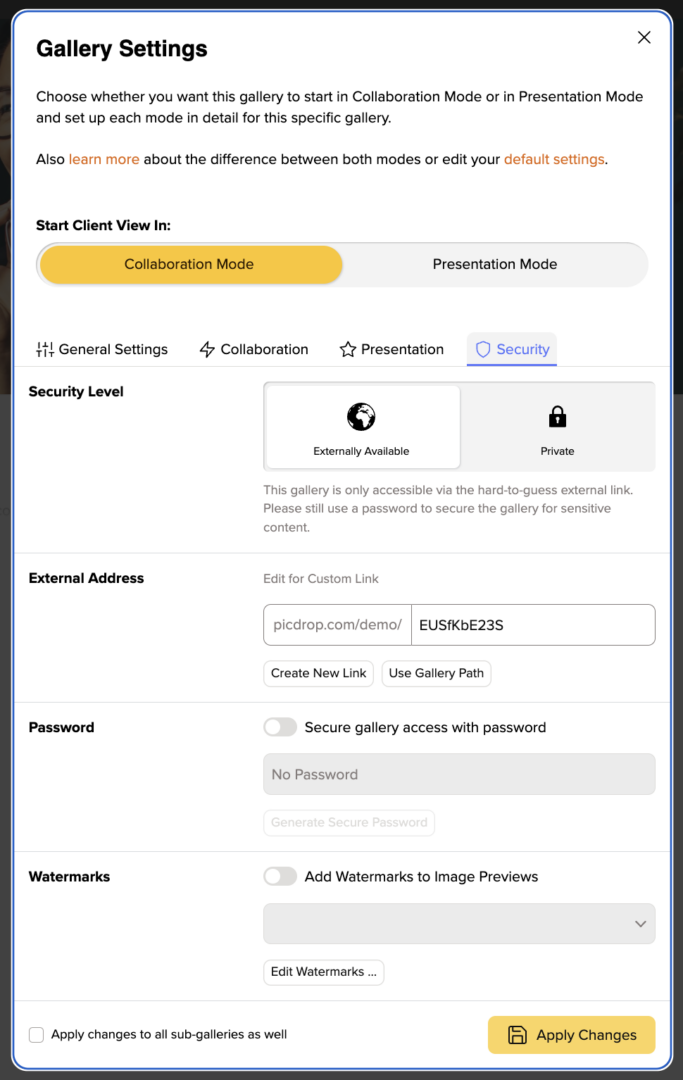While file-sharing platforms like WeTransfer, Dropbox or Google Drive allow you to send large photos and videos to clients and teams, their core functionalities are mainly limited to media file transfer. Modern photo sharing websites like picdrop, for example, are often built with complementary photo galleries and photo proofing features tailored towards professional photographers. This fundamental difference significantly streamlines photography workflows and improves the client experience.
Let’s explore the essential features that are required for an ideal photo sharing website, including design customization, gallery link validity period, and an integrated photo feedback system.
Why File Sharing Platforms Fall Short for Delivering Photos
The sheer volume of photos professional photographers share with clients and teams can easily become overwhelming. Without proper organization, it often results in scattered files and a confusing photo feedback process.
Imagine this common scenario:
Using Dropbox, you share one photo folder via link A and another folder using link B. Then, you switch to email to collect the client feedback, manually trying to match their comments with the correct images. Once completed, you re-upload the edited photos through another link for the final photo delivery. Quite frustrating and lengthy, right? Imagine this inefficient approach across several projects – and many professional photographers still do it that way. As you can tell, this process is not sustainable.
Now, picture this instead:
You have one dedicated photo gallery per client. No matter how many times you upload new photos and videos, the link remains consistent and active indefinitely. Instead of constantly switching between emails and trying to match image file names, all photo feedback is centralized and directly associated with the images within the gallery.
If scenario two appeals to you, choosing a dedicated client photo delivery software over file sharing platforms will provide you with a more efficient and client-centric photography approach. It’s easily the best way to share photos with clients.
So, to help you out, we’ve explored the essential features to look for in a photo sharing website.
6 Must-Have Features of Modern Photo Sharing Websites
1. Customizable Client Photo Gallery for the Best Photo Viewing Experience

When clients access their photos, it shouldn’t feel like a bland file transfer; it should be an extension of your artistic vision. This is where a photo sharing tool with a customizable online photo gallery feature shines.
Instead of showcasing the photos through the generic, uninspired interfaces on Dropbox or WeTransfer, a professional photo gallery allows you to add your brand aesthetic into the photo presentation.
For example, with picdrop, you can change the photo gallery color palette, choose the cover image, add a welcome message, and more. Think beyond simple grids, and tailor the online client photo gallery to highlight individual images or create a cohesive visual story.
Related: Struggling to keep your photoshoot files organized? These 7 tips on managing a large client photo gallery can help.
2. Client Photo Proofing for Streamlined Photo Approval and Selection Processes

Juggling separate tools for photo sharing and photo proofing can introduce unnecessary friction into your workflow and create a disjointed client experience. Clients must switch between viewing photos in one place and providing feedback in another. The same inefficiency applies when you review their comments, bouncing back and forth between tabs.
A photo sharing website with a built-in photo proofing feature streamlines the image collaboration process. Clients can directly flag, like and comment on individual photos and annotate specific areas for detailed editing, reducing misunderstandings and accelerating problem resolution.
3. Photo and Video Sharing in Various File Formats and Sizes
One significant drawback of relying on basic cloud file transfer services to share photos is the file size and quality restrictions. This can force you into time-consuming workarounds like compressing high-resolution images or splitting large media files into multiple folders for bite-sized delivery.
To avoid this, look for an online photo sharing site that allows large and unaltered file uploads. You should also consider the upload speed. A slow photo delivery solution can significantly hinder your workflow, turning a simple sharing task into a lengthy ordeal.
Additionally, if your work involves sharing media files in various formats, such as JPEG, RAW, MP4, and more, ensure that your chosen photo sharing website offers comprehensive format support and previews. You don’t want to be burdened by converting files before you can share them with your teams, editors, or clients.
4. Mobile-Responsive Client Photo Galleries for On-the-Go Viewing
The likelihood of your clients viewing your photos on desktop computers is low. They might rather browse them during their commute or while relaxing, on a tablet or mobile phone. Therefore, make sure your chosen photo sharing tool is optimized for mobiles.
This will provide a consistently visually appealing photo gallery layout, even on smaller screens. Moreover, it guarantees readable text, proper functionality of all buttons and navigation, and quick loading times whenever your clients interact with the gallery.
5. Secure and Private Photo Delivery, Protected by Passwords

Your clients trust you to capture their precious memories, which makes the security and privacy of their photos and videos crucial. They expect their visual assets to be protected from unauthorized access and not exploited for purposes like training AI systems.
Look for photo sharing platforms that customize granular access, allowing you to implement essential safeguards. This includes setting up password protection, applying watermarks to the files, and disabling download options to let you control whether clients can download the images.
6. Permanent Live Links to the Client Photo Galleries
File transfer services like WeTransfer typically set an expiration date on shared links, which can be inconvenient for photography businesses focused on excellent and long lasting client service.
Consequently, you might repeatedly chase clients to ensure timely photo review and file download before the links become inactive. And when a client needs access to their photos after the link expiration date, you’ll have to re-upload and re-share the files again.
Investing in photo sharing software that provides permanent live client photo gallery links eliminates this recurring hassle. Once shared, the gallery remains accessible indefinitely – until you, the photographer, decides otherwise. This means that if clients misplace their photos, you can simply resend the original gallery link. They can then download their images independently without requiring you to re-upload anything.
Why picdrop is the Best Online Photo Sharing Website for Photographers
Now that you know the key features of a reliable photo sharing solution, the question remains: which software offers all of them? The answer of course is picdrop.
Built by photographers for photographers, picdrop gives you everything you need to deliver beautiful client photo galleries with intuitive feedback functionality. Use the Collaboration Mode for the photo proofing and selection stage, then switch to the Presentation Mode for the final photo delivery. This combination helps you achieve a smooth client journey from start to finish.
In Collaboration Mode, clients can effortlessly select their preferred images (and indicate those they don’t) using intuitive ‘yes’ or ‘no’ markers, color flags, or likes. Providing feedback is equally straightforward: clients simply select photos to leave comments or even annotate directly on the images.
This streamlined process allows you to efficiently filter the selected photos based on client feedback (for example, all ‘yes’ marked images). Then, seamlessly export the file names to Adobe Lightroom or Capture One in seconds, creating a truly integrated editing workflow.
See how picdrop’s photo proofing and client collaboration feature works in this demo video:
Once your edits are complete, you can easily reshare the finalized images using the Presentation Mode. Customize the look and feel by selecting the most impactful image as the gallery cover and adjusting elements like font style, image spacing, and background color to perfectly showcase your work.
With its comprehensive suite of features, picdrop stands out as the best WeTransfer alternative for professional photographers, offering a purpose-built photo sharing solution that goes far beyond simple file transfer.
Learn more about how to use picdrop and leverage its smart features.
Seamlessly Deliver Photos to Clients and Teams with picdrop
While cloud file transfer services allow you to share photos with clients, they often lack the specialized features that professional photographers need. For photographers who prioritize a frictionless delivery process, investing in the right photo sharing software is essential.
Try out picdrop‘s photo sharing solution. Its rich features, seamless integration with photo editing software, and user-friendly interface make photo sharing and photo proofing remarkably easy for you and your clients.
Experience the benefits of picdrop firsthand and share your feedback with us. Get started for free with our four week trial with all features! No strings attached: after the trial period your account will automatically switch a forever-free plan or you can upgrade to a paid plan.
Are you new to the photography business? Our experts offer their top tips for getting off the ground and achieving growth:
- How to Start a Photography Business (detailed guide)
- 5 Best Software for Each Stage of Your Photography Workflow
- Professional Photography Pricing Guide (with rate examples)
FAQs About Essential Features of A Photo Sharing Website Should Have
What’s the Best Platform for Sharing High-Res Photos With Clients Professionally?
The best platform for sharing high-res photos with clients professionally is picdrop. Unlike many tools that compress or resize your images, picdrop preserves full resolution, so your work always looks its best. It supports popular photo formats (TIFF, RAW, PSD, etc.), so there’s no need to convert files before sharing. Plus, with an easy drag-and-drop uploader and lightning-fast performance, picdrop saves valuable time, especially when you’re managing hundreds of images on tight deadlines.
Which Software Do Professional Photographers Use to Share Galleries?
Many professional photographers use picdrop to share galleries in two key stages: photo proofing and final delivery. Clients can review images, leave comments, and mark favorites during the proofing stage using picdrop’s built-in annotation tools. For final delivery, photographers can customize gallery designs to present high-resolution photos in a polished, professional way. This dual-purpose workflow makes picdrop a professional photographer’s favorite for collaborating and showcasing finished work.



